Deck 11: B: The Aggregate Expenditures Model
Question
Question
Question
Question
Question
Question
Question
Question
Question
Question
Question
Question
Question
Question
Question
Question
Question
Question
Question
Question
Question
Question
Question
Question
Question
Question
Question
Question
Question
Question
Question
Question
Question
Question
Question
Question
Question
Question
Question
Question
Question
Question
Question
Question
Question
Question
Question
Question
Question
Question
Question
Question
Question
Question
Question
Question
Question
Question
Question
Question
Question
Question
Question
Question
Question
Question
Question
Question
Question
Question
Question
Question
Question
Question
Question
Question
Question
Question
Question
Question

Unlock Deck
Sign up to unlock the cards in this deck!
Unlock Deck
Unlock Deck
1/238
Play
Full screen (f)
Deck 11: B: The Aggregate Expenditures Model
1
During the recession of 2008-2009, both after-tax consumption and government expenditures declined.
False
2
Exports are added to, and imports are subtracted from, aggregate expenditures in moving from a closed to an open economy.
True
3
Refer to the diagram below.The equilibrium condition for a private closed economy is Ig = S. 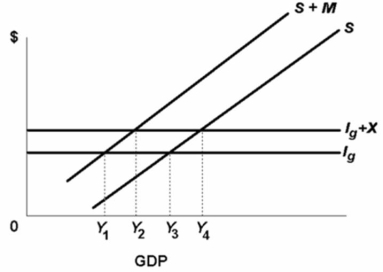

True
4
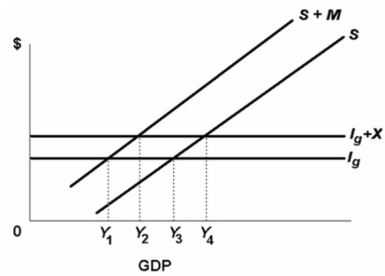 Refer to the above diagram.The equilibrium condition for a private open economy is S + M = Ig + X.
Refer to the above diagram.The equilibrium condition for a private open economy is S + M = Ig + X.
Unlock Deck
Unlock for access to all 238 flashcards in this deck.
Unlock Deck
k this deck
5
For given data the aggregate expenditures-domestic output and the saving-investment approaches will yield the same equilibrium level of GDP.

Unlock Deck
Unlock for access to all 238 flashcards in this deck.
Unlock Deck
k this deck
6
A recessionary expenditure gap in a mixed open economy can be measured as the extent to which aggregate expenditures fall short of those required to achieve the full-employment GDP.

Unlock Deck
Unlock for access to all 238 flashcards in this deck.
Unlock Deck
k this deck
7
For an open mixed economy the equilibrium level of GDP is determined where Sa + Ig + X = T +G.

Unlock Deck
Unlock for access to all 238 flashcards in this deck.
Unlock Deck
k this deck
8
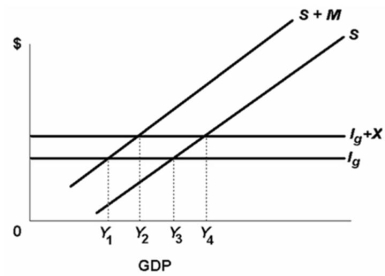 Refer to the above diagram.In equilibrium net exports are positive.
Refer to the above diagram.In equilibrium net exports are positive.
Unlock Deck
Unlock for access to all 238 flashcards in this deck.
Unlock Deck
k this deck
9
If the MPC is.9, a $20 billion increase in a lump-sum tax will reduce GDP by $200 billion.

Unlock Deck
Unlock for access to all 238 flashcards in this deck.
Unlock Deck
k this deck
10
The recessionary expenditure gap is the amount by which the equilibrium GDP and the full-employment GDP differ.

Unlock Deck
Unlock for access to all 238 flashcards in this deck.
Unlock Deck
k this deck
11
If government decreases its purchases by $20 billion and the MPC is 0.8, equilibrium GDP will decrease by $100 billion.

Unlock Deck
Unlock for access to all 238 flashcards in this deck.
Unlock Deck
k this deck
12
The Sa + M + T schedule has a negative slope.

Unlock Deck
Unlock for access to all 238 flashcards in this deck.
Unlock Deck
k this deck
13
The equilibrium level of GDP always coincides with the full-employment GDP.

Unlock Deck
Unlock for access to all 238 flashcards in this deck.
Unlock Deck
k this deck
14
Equal increases in government expenditures and tax collections will leave the equilibrium GDP unchanged.

Unlock Deck
Unlock for access to all 238 flashcards in this deck.
Unlock Deck
k this deck
15
A lump-sum tax causes the after-tax consumption schedule to be flatter than the before-tax consumption schedule.

Unlock Deck
Unlock for access to all 238 flashcards in this deck.
Unlock Deck
k this deck
16
During the recession of 2008-2009 the federal government undertook various policies intended to stimulate private spending and investment.

Unlock Deck
Unlock for access to all 238 flashcards in this deck.
Unlock Deck
k this deck
17
In reality, if a nation imposes tariffs, then the final result will be that net exports and GDP will decrease.

Unlock Deck
Unlock for access to all 238 flashcards in this deck.
Unlock Deck
k this deck
18
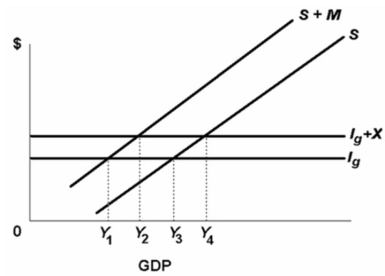 Refer to the above diagram.The equilibrium level of GDP for this private open economy is Y3.
Refer to the above diagram.The equilibrium level of GDP for this private open economy is Y3.
Unlock Deck
Unlock for access to all 238 flashcards in this deck.
Unlock Deck
k this deck
19
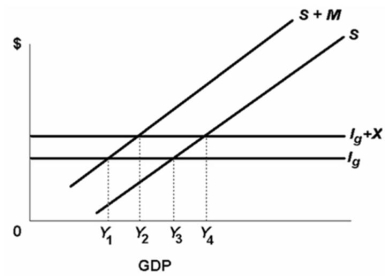 Refer to the above diagram.International trade has an expansionary effect on this economy.
Refer to the above diagram.International trade has an expansionary effect on this economy.
Unlock Deck
Unlock for access to all 238 flashcards in this deck.
Unlock Deck
k this deck
20
A $10 billion decrease in taxes will increase the equilibrium GDP by more than would a $10 billion increase in government expenditures.

Unlock Deck
Unlock for access to all 238 flashcards in this deck.
Unlock Deck
k this deck
21
The equilibrium GDP is the level of domestic output:
A)where consumption equals saving.
B)where actual investment equals consumption.
C)which is sustainable.
D)where full employment exists.
A)where consumption equals saving.
B)where actual investment equals consumption.
C)which is sustainable.
D)where full employment exists.

Unlock Deck
Unlock for access to all 238 flashcards in this deck.
Unlock Deck
k this deck
22
 Refer to the above information.If the real interest rate is 20 percent, the equilibrium level of GDP will be:
Refer to the above information.If the real interest rate is 20 percent, the equilibrium level of GDP will be:A)$100
B)$200
C)$300
D)$400

Unlock Deck
Unlock for access to all 238 flashcards in this deck.
Unlock Deck
k this deck
23
 Refer to the above information.When the real interest rate is 10 percent, unplanned changes in inventories are equal to:
Refer to the above information.When the real interest rate is 10 percent, unplanned changes in inventories are equal to:A)$40
B)-$30.
C)$20
D)-$60.

Unlock Deck
Unlock for access to all 238 flashcards in this deck.
Unlock Deck
k this deck
24
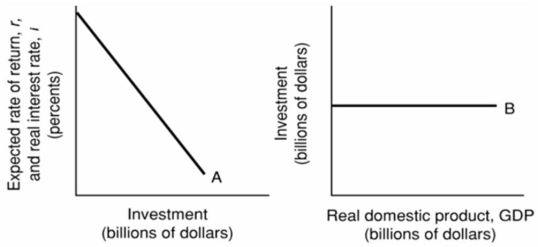 Refer to the above diagrams.Curve A:
Refer to the above diagrams.Curve A:A)is an investment schedule and curve B is a consumption of fixed capital schedule.
B)is an investment demand curve and curve B is an investment schedule.
C)and B are totally unrelated.
D)shifts to the left when curve B shifts upward.

Unlock Deck
Unlock for access to all 238 flashcards in this deck.
Unlock Deck
k this deck
25
All else equal, a large decline in the real interest rate will shift the:
A)investment-demand curve leftward.
B)investment-demand curve rightward.
C)investment schedule upward.
D)investment schedule downward.
A)investment-demand curve leftward.
B)investment-demand curve rightward.
C)investment schedule upward.
D)investment schedule downward.

Unlock Deck
Unlock for access to all 238 flashcards in this deck.
Unlock Deck
k this deck
26
For a private closed economy aggregate expenditures consist of:
A)C + Ig.
B)C - Ig.
C)C + S.
D)C - S.
A)C + Ig.
B)C - Ig.
C)C + S.
D)C - S.

Unlock Deck
Unlock for access to all 238 flashcards in this deck.
Unlock Deck
k this deck
27
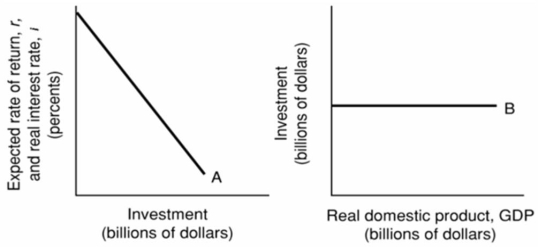 Refer to the above diagrams.Other things equal, an interest rate decrease will:
Refer to the above diagrams.Other things equal, an interest rate decrease will:A)shift curve A to the right and shift curve B upward.
B)shift curve A to the left and shift curve B downward.
C)leave curve A in place but shift curve B downward.
D)leave curve A in place but shift curve A upward.

Unlock Deck
Unlock for access to all 238 flashcards in this deck.
Unlock Deck
k this deck
28
In the aggregate expenditures model, it is assumed that the planned investment:
A)automatically changes in response to changes in the current level of real domestic output.
B)changes by less in percentage terms than changes in the level of real domestic output.
C)does not respond to changes in interest rates.
D)does not change when the level of real domestic output changes.
A)automatically changes in response to changes in the current level of real domestic output.
B)changes by less in percentage terms than changes in the level of real domestic output.
C)does not respond to changes in interest rates.
D)does not change when the level of real domestic output changes.

Unlock Deck
Unlock for access to all 238 flashcards in this deck.
Unlock Deck
k this deck
29
In a private closed economy (a) the marginal propensity to save is 0.25, (b) consumption equals income when consumption is $120 billion, and (c) the level of investment is $40 billion.What is the equilibrium level of income?
A)$280 billion
B)$320 billion
C)$262 billion
D)$198 billion
A)$280 billion
B)$320 billion
C)$262 billion
D)$198 billion

Unlock Deck
Unlock for access to all 238 flashcards in this deck.
Unlock Deck
k this deck
30
Refer to the below data.Equilibrium Y = (GDP) is: The letters Y, C, and, I are used to represent GDP, consumption, and, investment respectively. 
A)$100
B)$200
C)$300
D)$400

A)$100
B)$200
C)$300
D)$400

Unlock Deck
Unlock for access to all 238 flashcards in this deck.
Unlock Deck
k this deck
31
 Refer to the above data.If gross investment is $120, the equilibrium level of GDP will be:
Refer to the above data.If gross investment is $120, the equilibrium level of GDP will be:A)$380
B)$370
C)$360
D)$400

Unlock Deck
Unlock for access to all 238 flashcards in this deck.
Unlock Deck
k this deck
32
Which of the following will cause the investment schedule to shift downward?
A)an increase in the real interest rate
B)a decline in wage rates
C)a significant decline in the real interest rate
D)a new technological advance which cuts the price of steel by one-half
A)an increase in the real interest rate
B)a decline in wage rates
C)a significant decline in the real interest rate
D)a new technological advance which cuts the price of steel by one-half

Unlock Deck
Unlock for access to all 238 flashcards in this deck.
Unlock Deck
k this deck
33
Refer to the data below.If gross investment is $10 at all levels of GDP, the equilibrium GDP will be: The following schedule contains data for a private closed economy.All figures are in billions. 
A)$300
B)$220
C)$260
D)$180

A)$300
B)$220
C)$260
D)$180

Unlock Deck
Unlock for access to all 238 flashcards in this deck.
Unlock Deck
k this deck
34
 Refer to the above information.If the real interest rate is 9 percent, the equilibrium level of GDP will be:
Refer to the above information.If the real interest rate is 9 percent, the equilibrium level of GDP will be:A)$600
B)$500
C)$400
D)$300

Unlock Deck
Unlock for access to all 238 flashcards in this deck.
Unlock Deck
k this deck
35
The level of aggregate expenditures in the private closed economy is determined by the:
A)expenditures of consumers and businesses.
B)intersection of the saving schedule and the 45-degree line.
C)equality of the MPC and MPS.
D)intersection of the saving and consumption schedules.
A)expenditures of consumers and businesses.
B)intersection of the saving schedule and the 45-degree line.
C)equality of the MPC and MPS.
D)intersection of the saving and consumption schedules.

Unlock Deck
Unlock for access to all 238 flashcards in this deck.
Unlock Deck
k this deck
36
 Refer to the above information.In this economy a 3 percentage point decrease in the interest rate will:
Refer to the above information.In this economy a 3 percentage point decrease in the interest rate will:A)increase equilibrium GDP by $200.
B)increase equilibrium GDP by $100.
C)increase equilibrium GDP by $50.
D)decrease equilibrium GDP by $50.

Unlock Deck
Unlock for access to all 238 flashcards in this deck.
Unlock Deck
k this deck
37
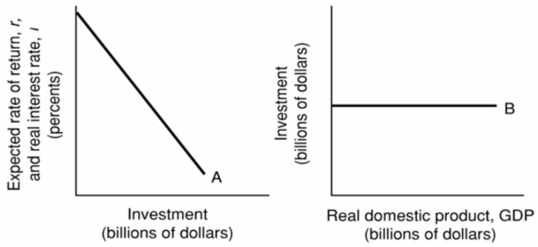 Refer to the above diagrams.Other things equal, Curve B will shift upward when:
Refer to the above diagrams.Other things equal, Curve B will shift upward when:A)the level of GDP increases.
B)the interest rate increases.
C)curve A shifts to the left.
D)curve A shifts to the right.

Unlock Deck
Unlock for access to all 238 flashcards in this deck.
Unlock Deck
k this deck
38
The relationship between investment and GDP is shown by the:
A)consumption of fixed capital schedule.
B)saving schedule.
C)investment schedule.
D)consumption schedule.
A)consumption of fixed capital schedule.
B)saving schedule.
C)investment schedule.
D)consumption schedule.

Unlock Deck
Unlock for access to all 238 flashcards in this deck.
Unlock Deck
k this deck
39
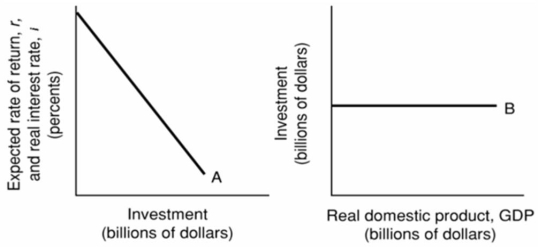 Refer to the above diagrams.Other things equal, an interest rate increase will:
Refer to the above diagrams.Other things equal, an interest rate increase will:A)shift curve A to the right and shift curve B upward.
B)shift curve A to the left and shift curve B downward.
C)leave curve A in place but shift curve B downward.
D)leave curve A in place but shift curve A upward.

Unlock Deck
Unlock for access to all 238 flashcards in this deck.
Unlock Deck
k this deck
40
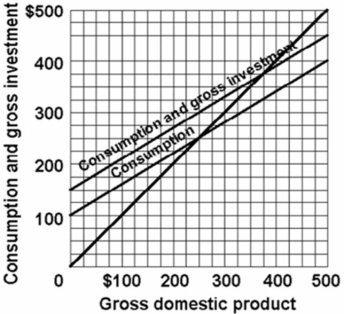 Refer to the above diagram for a private closed economy.The equilibrium level of GDP is:
Refer to the above diagram for a private closed economy.The equilibrium level of GDP is:A)$400
B)$300
C)$250
D)$375

Unlock Deck
Unlock for access to all 238 flashcards in this deck.
Unlock Deck
k this deck
41
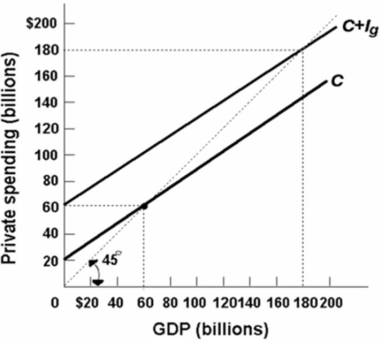 Refer to the above diagram for a private closed economy.In this economy, aggregate expenditures:
Refer to the above diagram for a private closed economy.In this economy, aggregate expenditures:A)do not change as GDP increases.
B)increase by $2 for every $5 increase in GDP.
C)increase by $2 for every $4 increase in GDP.
D)increase by $2 for every $3 increase in GDP.

Unlock Deck
Unlock for access to all 238 flashcards in this deck.
Unlock Deck
k this deck
42
In the aggregate expenditures model, equilibrium GDP in a private closed economy is indicated by:
A)the equality of saving and planned investment.
B)the intersection of aggregate expenditures and the 45-degree line.
C)the absence of unplanned changes in inventories.
D)all of the above.
A)the equality of saving and planned investment.
B)the intersection of aggregate expenditures and the 45-degree line.
C)the absence of unplanned changes in inventories.
D)all of the above.

Unlock Deck
Unlock for access to all 238 flashcards in this deck.
Unlock Deck
k this deck
43
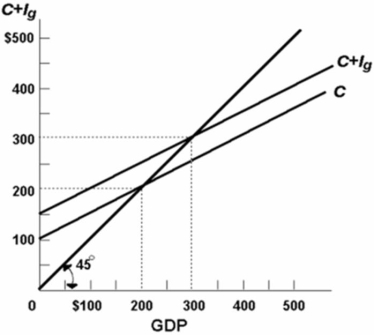 Refer to the above diagram for a private closed economy.At the $300 level of GDP:
Refer to the above diagram for a private closed economy.At the $300 level of GDP:A)aggregate expenditures and GDP are equal.
B)consumption is $250 and planned investment is $50.
C)saving equals investment.
D)all of the above are true.

Unlock Deck
Unlock for access to all 238 flashcards in this deck.
Unlock Deck
k this deck
44
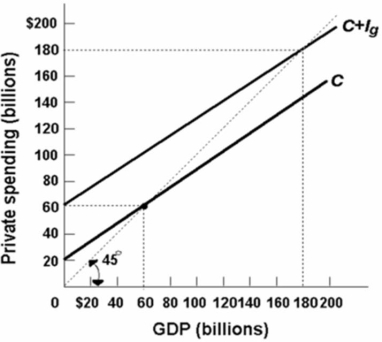 Refer to the above diagram for a private closed economy.In this economy investment:
Refer to the above diagram for a private closed economy.In this economy investment:A)decreases as GDP increases.
B)increases as GDP increases.
C)is $40 billion at all levels of GDP.
D)is $60 billion at all levels of GDP.

Unlock Deck
Unlock for access to all 238 flashcards in this deck.
Unlock Deck
k this deck
45
In a private closed economy, aggregate expenditures will equal GDP where:
A)consumption equals investment.
B)consumption plus investment equals aggregate expenditures.
C)planned investment equals saving.
D)disposable income equals consumption minus saving.
A)consumption equals investment.
B)consumption plus investment equals aggregate expenditures.
C)planned investment equals saving.
D)disposable income equals consumption minus saving.

Unlock Deck
Unlock for access to all 238 flashcards in this deck.
Unlock Deck
k this deck
46
When investment remains the same at each level of GDP in a private closed economy, the slope of the aggregate expenditures schedule:
A)exceeds the MPC.
B)is less than the MPC.
C)equals the MPS.
D)equals the MPC.
A)exceeds the MPC.
B)is less than the MPC.
C)equals the MPS.
D)equals the MPC.

Unlock Deck
Unlock for access to all 238 flashcards in this deck.
Unlock Deck
k this deck
47
In a private closed economy, where aggregate expenditures exceed domestic output:
A)domestic output will decline to the break-even level.
B)business inventories will rise.
C)saving exceeds planned investment.
D)planned investment exceeds saving.
A)domestic output will decline to the break-even level.
B)business inventories will rise.
C)saving exceeds planned investment.
D)planned investment exceeds saving.

Unlock Deck
Unlock for access to all 238 flashcards in this deck.
Unlock Deck
k this deck
48
The equilibrium level of GDP in a private closed economy is where:
A)MPC = APC.
B)unemployment is about 3 percent of the labor force.
C)planned consumption equals saving.
D)saving equals planned investment.
A)MPC = APC.
B)unemployment is about 3 percent of the labor force.
C)planned consumption equals saving.
D)saving equals planned investment.

Unlock Deck
Unlock for access to all 238 flashcards in this deck.
Unlock Deck
k this deck
49
Achieving aggregate equilibrium in the economy is indicated by:
A)an equality of saving and planned investment.
B)an equality of aggregate expenditures and domestic output.
C)the absence of unplanned investment or disinvestment.
D)all of the above.
A)an equality of saving and planned investment.
B)an equality of aggregate expenditures and domestic output.
C)the absence of unplanned investment or disinvestment.
D)all of the above.

Unlock Deck
Unlock for access to all 238 flashcards in this deck.
Unlock Deck
k this deck
50
Refer to the diagram below for a private closed economy.Saving and planned investment are equal: 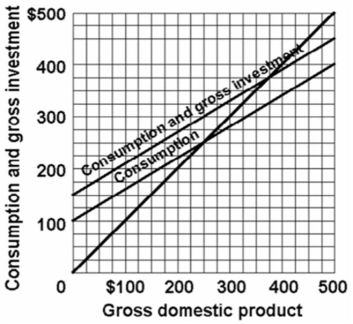
A)only at the $300 level of GDP.
B)only at the $250 level of GDP.
C)at all levels of GDP.
D)only at the $375 level of GDP.

A)only at the $300 level of GDP.
B)only at the $250 level of GDP.
C)at all levels of GDP.
D)only at the $375 level of GDP.

Unlock Deck
Unlock for access to all 238 flashcards in this deck.
Unlock Deck
k this deck
51
If aggregate expenditures exceed the domestic output in a private closed economy:
A)leakages will exceed injections.
B)planned investment will exceed saving.
C)unplanned investment in inventories will occur.
D)saving will exceed planned investment.
A)leakages will exceed injections.
B)planned investment will exceed saving.
C)unplanned investment in inventories will occur.
D)saving will exceed planned investment.

Unlock Deck
Unlock for access to all 238 flashcards in this deck.
Unlock Deck
k this deck
52
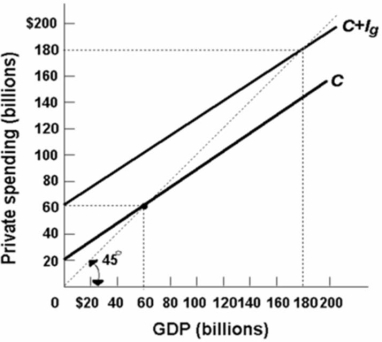 Refer to the above diagram for a private closed economy.Aggregate saving in this economy will be zero when:
Refer to the above diagram for a private closed economy.Aggregate saving in this economy will be zero when:A)C + Ig cuts the 45-degree line.
B)GDP is $180 billion.
C)GDP is $60 billion.
D)GDP is also zero.

Unlock Deck
Unlock for access to all 238 flashcards in this deck.
Unlock Deck
k this deck
53
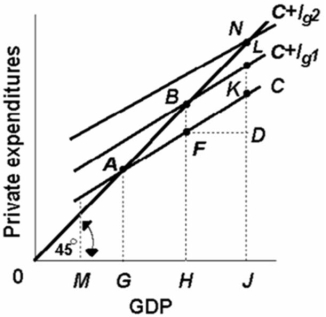 Refer to the above diagram which applies to a private closed economy.If gross investment is Ig1, the equilibrium GDP and the level of consumption will be:
Refer to the above diagram which applies to a private closed economy.If gross investment is Ig1, the equilibrium GDP and the level of consumption will be:A)H and HB respectively.
B)J and JI respectively.
C)J and JK respectively
D)H and HF respectively.

Unlock Deck
Unlock for access to all 238 flashcards in this deck.
Unlock Deck
k this deck
54
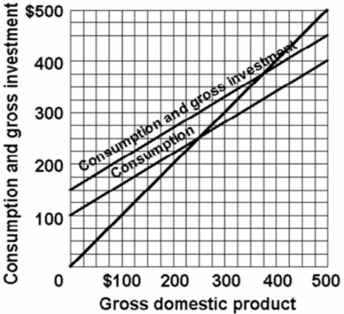 Refer to the above diagram for a private closed economy.At the equilibrium level of GDP saving is:
Refer to the above diagram for a private closed economy.At the equilibrium level of GDP saving is:A)$10
B)$20
C)$30
D)$50

Unlock Deck
Unlock for access to all 238 flashcards in this deck.
Unlock Deck
k this deck
55
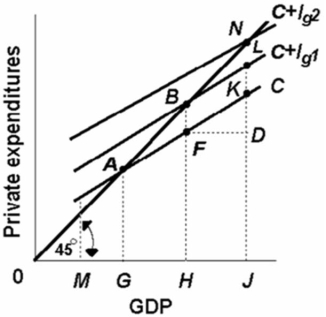 Refer to the above diagram which applies to a private closed economy.If gross investment increases from Ig1 to Ig2, the equilibrium GDP will:
Refer to the above diagram which applies to a private closed economy.If gross investment increases from Ig1 to Ig2, the equilibrium GDP will:A)decrease by KD.
B)increase by HJ.
C)increase by KD.
D)increase by GH.

Unlock Deck
Unlock for access to all 238 flashcards in this deck.
Unlock Deck
k this deck
56
Investment and saving are, respectively:
A)income and wealth.
B)stocks and flows.
C)injections and leakages.
D)leakages and injections.
A)income and wealth.
B)stocks and flows.
C)injections and leakages.
D)leakages and injections.

Unlock Deck
Unlock for access to all 238 flashcards in this deck.
Unlock Deck
k this deck
57
The equilibrium level of GDP is associated with:
A)an excess of planned investment over saving.
B)no unintended investment in inventories.
C)an unintended decrease in business inventories.
D)an unintended increase in business inventories.
A)an excess of planned investment over saving.
B)no unintended investment in inventories.
C)an unintended decrease in business inventories.
D)an unintended increase in business inventories.

Unlock Deck
Unlock for access to all 238 flashcards in this deck.
Unlock Deck
k this deck
58
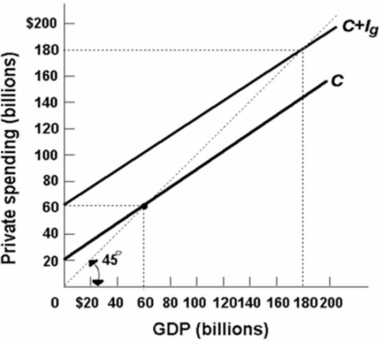 Refer to the above diagram for a private closed economy.The equilibrium level of GDP in this economy:
Refer to the above diagram for a private closed economy.The equilibrium level of GDP in this economy:A)is $60 billion.
B)is $180 billion.
C)is between $60 and $180 billion.
D)cannot be determined from the information given.

Unlock Deck
Unlock for access to all 238 flashcards in this deck.
Unlock Deck
k this deck
59
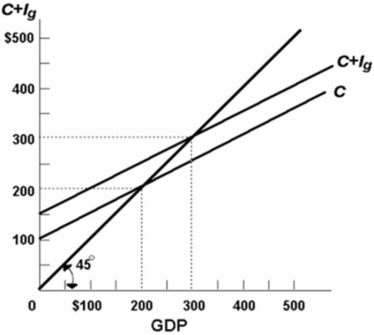 Refer to the above diagram for a private closed economy.At the $400 level of GDP:
Refer to the above diagram for a private closed economy.At the $400 level of GDP:A)aggregate expenditures exceed GDP with the result that GDP will rise.
B)consumption is $350 and planned investment is zero so that aggregate expenditures are $350.
C)consumption is $300 and planned investment is $50 so that aggregate expenditures are $350.
D)consumption is $300 and actual investment is $100 so that aggregate expenditures are $400.

Unlock Deck
Unlock for access to all 238 flashcards in this deck.
Unlock Deck
k this deck
60
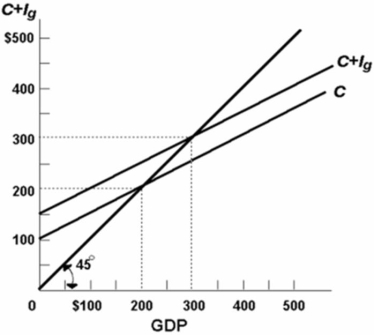 Refer to the above diagram for a private closed economy.At the $200 level of GDP:
Refer to the above diagram for a private closed economy.At the $200 level of GDP:A)consumption is $200 and planned investment is $50 so that aggregate expenditures are $250.
B)consumption is $200 and planned investment is $100 so that aggregate expenditures are $300.
C)consumption is $250 and actual investment is $50 so that aggregate expenditures are $300.
D)aggregate expenditures is equal to the GDP.

Unlock Deck
Unlock for access to all 238 flashcards in this deck.
Unlock Deck
k this deck
61
Which of the following statements is correct for a private closed economy?
A)Saving equals planned investment only at the equilibrium level of domestic output.
B)All levels of domestic output where planned investment exceeds saving will be too high for equilibrium.
C)Planned and actual investment are identical at all possible levels of domestic output.
D)Saving equals actual investment only at the equilibrium level of domestic output.
A)Saving equals planned investment only at the equilibrium level of domestic output.
B)All levels of domestic output where planned investment exceeds saving will be too high for equilibrium.
C)Planned and actual investment are identical at all possible levels of domestic output.
D)Saving equals actual investment only at the equilibrium level of domestic output.

Unlock Deck
Unlock for access to all 238 flashcards in this deck.
Unlock Deck
k this deck
62
For a private closed economy, an unplanned decline in inventories suggests that:
A)aggregate expenditures are less than the business sector expected them to be.
B)planned investment is greater than saving.
C)actual investment exceeds saving.
D)planned investment is greater than consumption.
A)aggregate expenditures are less than the business sector expected them to be.
B)planned investment is greater than saving.
C)actual investment exceeds saving.
D)planned investment is greater than consumption.

Unlock Deck
Unlock for access to all 238 flashcards in this deck.
Unlock Deck
k this deck
63
If an unplanned increase in business inventories occurs:
A)we can expect aggregate production to be unaffected.
B)we can expect businesses to increase the level of production.
C)we can expect businesses to lower the level of production.
D)aggregate expenditures must exceed the domestic output.
A)we can expect aggregate production to be unaffected.
B)we can expect businesses to increase the level of production.
C)we can expect businesses to lower the level of production.
D)aggregate expenditures must exceed the domestic output.

Unlock Deck
Unlock for access to all 238 flashcards in this deck.
Unlock Deck
k this deck
64
Planned investment equals saving:
A)at all levels of GDP.
B)at all below-equilibrium levels of GDP.
C)at all above-equilibrium levels of GDP.
D)only at the equilibrium GDP.
A)at all levels of GDP.
B)at all below-equilibrium levels of GDP.
C)at all above-equilibrium levels of GDP.
D)only at the equilibrium GDP.

Unlock Deck
Unlock for access to all 238 flashcards in this deck.
Unlock Deck
k this deck
65
Planned investment is $75 billion and saving is $62 billion in a private closed economy.In equilibrium actual investment must be:
A)$13 billion.
B)$75 billion.
C)$62 billion.
D)minus $13 billion.
A)$13 billion.
B)$75 billion.
C)$62 billion.
D)minus $13 billion.

Unlock Deck
Unlock for access to all 238 flashcards in this deck.
Unlock Deck
k this deck
66
The economy will expand when:
A)actual GDP is less than potential GDP.
B)planned investment exceeds saving.
C)saving exceeds planned investment.
D)unplanned investment occurs.
A)actual GDP is less than potential GDP.
B)planned investment exceeds saving.
C)saving exceeds planned investment.
D)unplanned investment occurs.

Unlock Deck
Unlock for access to all 238 flashcards in this deck.
Unlock Deck
k this deck
67
Refer to the diagram below for a private closed economy.In equilibrium the level of consumption: 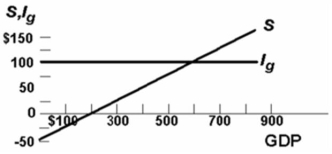
A)will be $100.
B)will be $500.
C)will be $600.
D)cannot be determined from the information given.

A)will be $100.
B)will be $500.
C)will be $600.
D)cannot be determined from the information given.

Unlock Deck
Unlock for access to all 238 flashcards in this deck.
Unlock Deck
k this deck
68
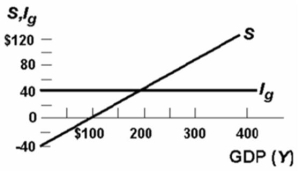 Refer to the above diagram for a private closed economy.At the $200 level of GDP:
Refer to the above diagram for a private closed economy.At the $200 level of GDP:A)consumption will equal GDP.
B)planned investment will equal saving and unintended investment will be zero.
C)aggregate expenditures will exceed GDP, causing GDP to rise.
D)GDP will exceed aggregate expenditures, causing GDP to fall.

Unlock Deck
Unlock for access to all 238 flashcards in this deck.
Unlock Deck
k this deck
69
 Refer to the above diagram which is for a private closed economy.All figures are in billions of dollars.If businesses were willing to invest $30 at each possible level of GDP, the equilibrium level of GDP would be:
Refer to the above diagram which is for a private closed economy.All figures are in billions of dollars.If businesses were willing to invest $30 at each possible level of GDP, the equilibrium level of GDP would be:A)$462.5.
B)$435.
C)$420.
D)$380.

Unlock Deck
Unlock for access to all 238 flashcards in this deck.
Unlock Deck
k this deck
70
If an unplanned increase in business inventories occurs at some level of GDP, then GDP:
A)entails a rate of aggregate expenditures in excess of the rate of aggregate production.
B)may be either above or below the equilibrium output.
C)is too low for equilibrium.
D)will decrease.
A)entails a rate of aggregate expenditures in excess of the rate of aggregate production.
B)may be either above or below the equilibrium output.
C)is too low for equilibrium.
D)will decrease.

Unlock Deck
Unlock for access to all 238 flashcards in this deck.
Unlock Deck
k this deck
71
In a private closed economy _____ investment is equal to saving at all levels of GDP and equilibrium occurs only at that level of GDP where _____ investment is equal to saving.
A)planned; actual
B)actual; planned
C)gross; net
D)net; gross
A)planned; actual
B)actual; planned
C)gross; net
D)net; gross

Unlock Deck
Unlock for access to all 238 flashcards in this deck.
Unlock Deck
k this deck
72
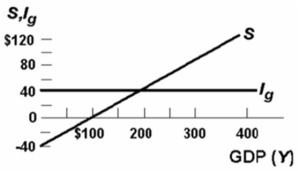 Refer to the above diagram for a private closed economy.At the $100 level of GDP:
Refer to the above diagram for a private closed economy.At the $100 level of GDP:A)aggregate expenditures will exceed GDP, causing GDP to fall.
B)planned investment will exceed saving, but actual investment will be equal to saving.
C)households will consume more than their income.
D)saving will be $40.

Unlock Deck
Unlock for access to all 238 flashcards in this deck.
Unlock Deck
k this deck
73
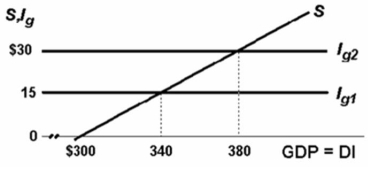 Refer to the above diagram which is for a private closed economy.All figures are in billions of dollars.If gross investment is $15, the equilibrium level of GDP:
Refer to the above diagram which is for a private closed economy.All figures are in billions of dollars.If gross investment is $15, the equilibrium level of GDP:A)is $30.
B)is $380.
C)is $300.
D)is $340.

Unlock Deck
Unlock for access to all 238 flashcards in this deck.
Unlock Deck
k this deck
74
In which of the following situations for a private closed economy will the level of GDP expand?
A)when planned investment exceeds saving
B)when planned investment exceeds consumption
C)when saving exceeds consumption
D)when consumption exceeds investment
A)when planned investment exceeds saving
B)when planned investment exceeds consumption
C)when saving exceeds consumption
D)when consumption exceeds investment

Unlock Deck
Unlock for access to all 238 flashcards in this deck.
Unlock Deck
k this deck
75
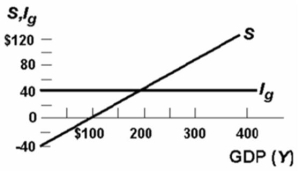 Refer to the above diagram for a private closed economy.At the $300 level of GDP:
Refer to the above diagram for a private closed economy.At the $300 level of GDP:A)planned investment will exceed saving, but actual investment will be equal to saving.
B)aggregate expenditures will exceed GDP, causing GDP to rise.
C)actual investment will exceed planned investment.
D)households will consume in excess of their incomes.

Unlock Deck
Unlock for access to all 238 flashcards in this deck.
Unlock Deck
k this deck
76
Assume that in a private closed economy consumption is $240 billion and investment is $50 billion at the $280 billion level of domestic output.Thus:
A)saving is $10 billion.
B)unplanned disinvestment of $10 billion will occur.
C)the MPC is.80.
D)unplanned investment of $10 billion will occur.
A)saving is $10 billion.
B)unplanned disinvestment of $10 billion will occur.
C)the MPC is.80.
D)unplanned investment of $10 billion will occur.

Unlock Deck
Unlock for access to all 238 flashcards in this deck.
Unlock Deck
k this deck
77
At the $180 billion equilibrium level of income, saving is $38 billion in a private closed economy.Planned investment must be:
A)$138 billion.
B)$126 billion.
C)$38 billion.
D)$180 billion.
A)$138 billion.
B)$126 billion.
C)$38 billion.
D)$180 billion.

Unlock Deck
Unlock for access to all 238 flashcards in this deck.
Unlock Deck
k this deck
78
Actual investment is $62 billion at an equilibrium output level of $620 billion in a private closed economy.The average propensity to save at this level of output:
A)is 0.10.
B)is 10.
C)is 0.62.
D)cannot be determined on the basis of the information given.
A)is 0.10.
B)is 10.
C)is 0.62.
D)cannot be determined on the basis of the information given.

Unlock Deck
Unlock for access to all 238 flashcards in this deck.
Unlock Deck
k this deck
79
If at some level of GDP the economy is experiencing an unplanned decrease in inventories:
A)the aggregate level of saving will decline.
B)the price level will fall.
C)the business sector will lay off workers.
D)domestic output will increase.
A)the aggregate level of saving will decline.
B)the price level will fall.
C)the business sector will lay off workers.
D)domestic output will increase.

Unlock Deck
Unlock for access to all 238 flashcards in this deck.
Unlock Deck
k this deck
80
The inequality of saving and planned investment:
A)is attributable to a low MPC.
B)may be of considerable significance because of the subsequent changes in income, employment, and the price level.
C)is of no consequence because a compensating inequality of tax collections and government spending will always occur.
D)is of no consequence because saving and actual investment will always be equal.
A)is attributable to a low MPC.
B)may be of considerable significance because of the subsequent changes in income, employment, and the price level.
C)is of no consequence because a compensating inequality of tax collections and government spending will always occur.
D)is of no consequence because saving and actual investment will always be equal.

Unlock Deck
Unlock for access to all 238 flashcards in this deck.
Unlock Deck
k this deck



